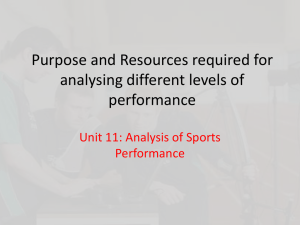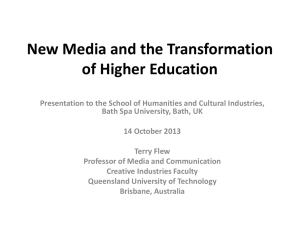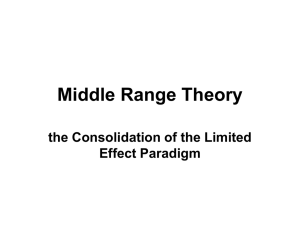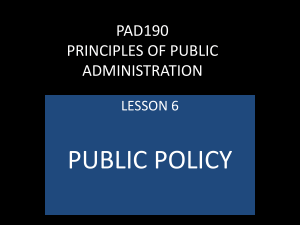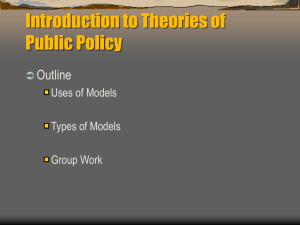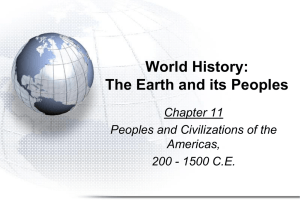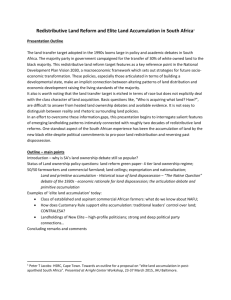The Educational Backgrounds of American Leaders: Status
advertisement
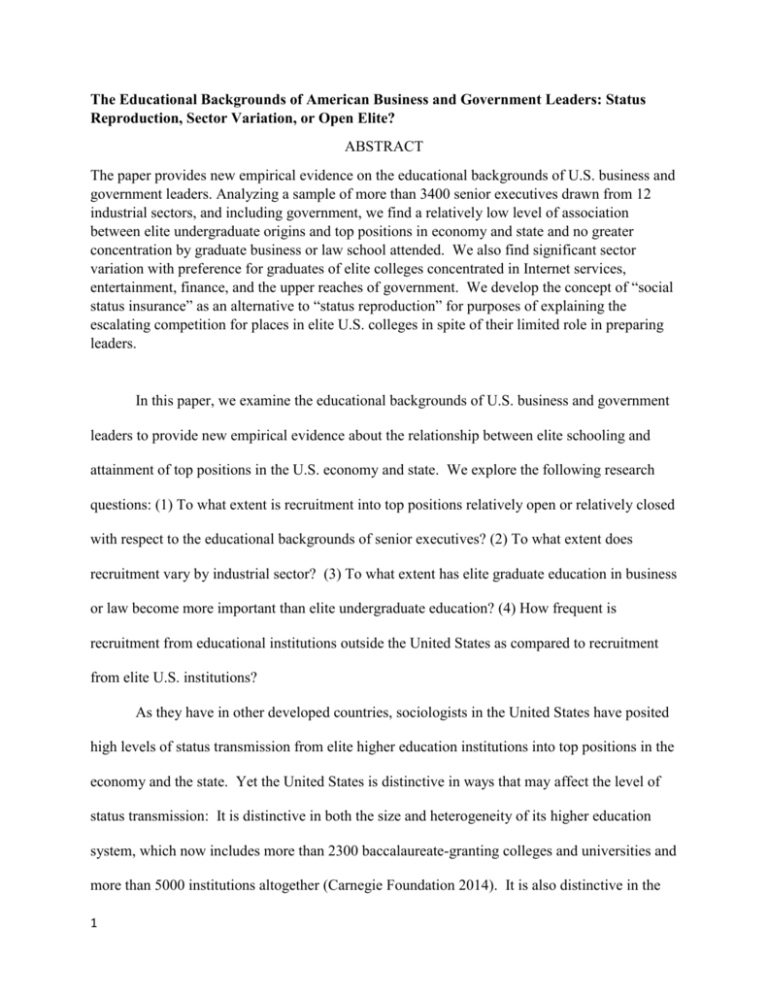
The Educational Backgrounds of American Business and Government Leaders: Status Reproduction, Sector Variation, or Open Elite? ABSTRACT The paper provides new empirical evidence on the educational backgrounds of U.S. business and government leaders. Analyzing a sample of more than 3400 senior executives drawn from 12 industrial sectors, and including government, we find a relatively low level of association between elite undergraduate origins and top positions in economy and state and no greater concentration by graduate business or law school attended. We also find significant sector variation with preference for graduates of elite colleges concentrated in Internet services, entertainment, finance, and the upper reaches of government. We develop the concept of “social status insurance” as an alternative to “status reproduction” for purposes of explaining the escalating competition for places in elite U.S. colleges in spite of their limited role in preparing leaders. In this paper, we examine the educational backgrounds of U.S. business and government leaders to provide new empirical evidence about the relationship between elite schooling and attainment of top positions in the U.S. economy and state. We explore the following research questions: (1) To what extent is recruitment into top positions relatively open or relatively closed with respect to the educational backgrounds of senior executives? (2) To what extent does recruitment vary by industrial sector? (3) To what extent has elite graduate education in business or law become more important than elite undergraduate education? (4) How frequent is recruitment from educational institutions outside the United States as compared to recruitment from elite U.S. institutions? As they have in other developed countries, sociologists in the United States have posited high levels of status transmission from elite higher education institutions into top positions in the economy and the state. Yet the United States is distinctive in ways that may affect the level of status transmission: It is distinctive in both the size and heterogeneity of its higher education system, which now includes more than 2300 baccalaureate-granting colleges and universities and more than 5000 institutions altogether (Carnegie Foundation 2014). It is also distinctive in the 1 number of large corporations that populate its economy and the cultural and political variability of the regions in which these corporations reside. These characteristics may lead to greater openness than is found in countries, such as France, in which strong connections have existed since Napoleonic times between elite higher education institutions and top positions in the economy and the state (Bourdieu 1996). We use the conventional definition of elite colleges as the most prestigious and selective baccalaureate-granting institutions in the country. The research questions we explore are timely because of the seemingly limitless interest of ambitious U.S. students to gain admission into elite colleges at a time when their costs are rapidly increasing. Altogether, the eight highly selective Eastern seaboard private colleges in the Ivy League1 received more than 247,000 applications in 2013 and accepted just 9 percent of applicants (Hernandez College Consulting 2013). By contrast, in 1987, these colleges received approximately 89,000 applications and accepted 26 percent (Persell & Cookson 1990). Students apply to many more schools than they did in the past, but that is not the only reason for falling admissions rates; many more top high school seniors are being urged to apply to selective colleges, and applicant pools now include tens of thousands of top students from outside the United States. Published costs for tuition, room and board now run approximately $250,000 over four years, double what they were just a decade ago (Jacobs 2014).2 By contrast, the median American family earned just over $50,000 in 2013 (Noss 2014) – or about $10,000 less than the full price of attendance at a highly selective college. Despite strong demand for an elite education, we find less status reproduction from elite educational institutions into top positions in the U.S. economy and state than previous studies have suggested, as well as sizable industry variation. The largest proportion of top executives in 2 our sample – well over half -- made their way into the elite without the benefit of either an elite undergraduate or an elite graduate degree. As one explanation for the openness of top positions in the economy and state, we emphasize the divergent selection criteria used for admission into elite colleges and those used for recruitment into powerful corporate and state positions. We also develop the concept of “social status insurance” to explain the competition for admission into elite institutions at a time when they are not closely connected to the attainment of top positions in business and government. STUDIES OF AMERICAN ELITE RECRUITMENT Beginning with the work of Mills (1956) and Baltzell (1964), critiques by American sociologists have emphasized the connection between elite schooling and leading positions in the American society and therefore fit into what has come to be known as “social reproduction” theory (Bourdieu & Passeron 1970). Subsequent critical studies by American scholars continued to assert strong connections between elite schooling and top positions in economy and state but, like their precursors, provided little systematic evidence on these connections (see, e.g., Domhoff 1970; 2006; Dye 1976, 1995). Qualitative studies have focused on the mechanisms used by elite boarding schools (Cookson & Persell 1987; Khan 2011) and elite undergraduate colleges (Karabel 2005; Soares 2007; Stevens 2007) to prepare adolescents and young adults for top positions in American society. These mechanisms include: institutional emphases on rigor and competition in and outside the classroom; student clubs and residence halls that foster long-term social relationships that can be valuable in career advancement; visits from distinguished alumni and others to provide practical advice and to serve as role models of accomplishment; opportunities for 3 impressive internships and travel experiences; and degrees that carry symbolic value in the labor market. In a notable recent contribution, Rivera (2012) showed high levels of status transmission from elite colleges into entry-level positions in leading investment banking, management consulting, and law firms. Most of the 120 recruiters Rivera studied refused to consider students from outside the top 25 undergraduate colleges and concentrated the most of their attention on students from no more than three or four schools. They congregated at these top colleges for weeks at a time during recruitment season, holding interviews in conjunction with glamorous parties and events (ibid.). The recruiters expressed similar reasons for focusing on students from elite colleges. They believed that these students were by definition top achievers. Having attended selective colleges themselves, the recruiters also saw validation and reflections of themselves in the students they recruited. Exclusion of students from non-elite schools also represented important time and cost savings for recruiters; firm employees recruited on a parttime basis and did not have time read hundreds of resumes. Quantitative studies were initially hampered by the slow development of college rankings. In the first large-scale empirical effort to examine the backgrounds of top executives, Useem & Karabel (1986) studied 3105 top executives drawn from 208 Fortune 500 firms in the year 1978. They examined groups of executives by their highest levels of education, looking separately at those who did not complete college, those who completed a baccalaureate degree, and those who completed a graduate degree. They found that more than one in eight (16.5 percent) of executives in 1978 had no college degree. Looking at only those executives without graduate degrees, they found that nearly 30 percent graduated from one of their Top 11 colleges. Another 14 percent of the sample (83 percent of all MBA holders) graduated from a Top 11 4 business school. Seven percent (43 percent of all law degree holders) graduated from a Top 9 law school. They also found that executives who served on multiple boards of directors were more likely to have attended an elite college and graduate school than executives at large. Ott (2011) replicated the Useem & Karabel (1986) study on a sample of 3789 executives drawn from 250 Fortune 500 firms in the year 2010. She followed the sector sampling distribution adopted by Useem and Karabel, including their approach to stratifying firms, as well as their criteria for selecting executives into sample, including all senior vice presidents and above as well as outside directors. She found that only two percent of 2010 top executives had no college degree. Of those who had attained a baccalaureate degree only, a much smaller proportion, 16 percent, had graduated from a Top 11 undergraduate college in 2010 than had in 1978. In 2010, a slightly higher proportion, 17 percent, had attained degrees from one of the Top 11 business schools, and a similar proportion, 6.5 percent had attained a degree from one of the Top 9 law schools. Capelli & Hatori (2004) studied all executives from a smaller population, the Fortune 100, in 1980 and 2001 focusing on the top 10 executives from each corporation, as identified in organizational charts. They distinguished between only three types of institutions: Ivy League universities, non-Ivy League private colleges and universities, and public universities. They examined baccalaureate, second, and third degree attainments, but did not distinguish among types of second or third degrees. They found a decline in Ivy League baccalaureates between 1980 and 2001, from 14 to 10 percent, and an increase in public university baccalaureates, from 32 to 48 percent. The same pattern held for second degrees (which they indicate were most often the MBA); Ivy league graduates fell between 1980 and 2001 from 35 to 21 percent, and public university graduates increased from 26 to 34 percent. A follow-up study by Capelli, Hatori & 5 Bonet (2014) of Fortune 100 executives in 2011 found stability over the decade in the proportion of Ivy League baccalaureates and continuing growth of public university baccalaureates as well as stability in the distribution of second degrees. Several debatable methodological choices and gaps in these quantitative analyses encourage further investigation of the links between elite educational institutions and top positions in the U.S. economy and state. First, none of the authors selects their list of elite institutions based on a span of years in which executives were enrolled in college; instead, they choose rankings from one year only. Second, given that baccalaureate attainment is far more common than graduate degree attainment, the decision to ascribe a similar number of undergraduate colleges and graduate schools as elite may lead to a misinterpretation of the relative importance of elite graduate degrees compared to elite undergraduate degrees. Third, the sector divisions used in the studies reflect an outdated view of the American economy as divided between manufacturing, retail and wholesale trade, transportation, utilities, and financial services. These divisions reflect the standard industrial codes used by the federal government prior to 1997. The new industrial codes, the North American Industry Classification Systems (see U.S. Bureau of the Census 2012), focus on more specific industries, such as entertainment and energy, in part because many large firms include both manufacturing and service divisions. Fourth, none of the studies paid close attention to specific educational pathways into the elite. Useem & Karabel (1986) and Ott (2011) examined one pathway only: from elite undergraduate education to an elite graduate MBA degree. Capelli and his associates do not explore pathways into top positions (Capelli & Hatori 2004; Capelli, Hatori, & Bonet 2014). Fifth, none of the authors examined in detail important recent developments in higher education and elite recruitment such as the internationalization of recruitment into top corporate positions. Finally, a 6 broader conception of top positions in American society would include top leaders in government as well as top corporate executives. Although government is, in many respects, dependent on private business in a capitalist economy, it also sets the terms under which private business operates and shapes at least to an equal degree the conditions of life for workers and citizens (for elaboration see, e.g., Skocpol 1985). HYPOTHESES Following one implication of the research by Ott (2011) and Capelli, Hatori & Bonet (2014), we investigate the hypothesis that elite undergraduate education is no longer common among top American business and government leaders. Following the explicit implication of studies in the status reproduction tradition such as Rivera (2012), we also investigate the contrasting hypothesis, that of relatively closed pathways from elite schooling to elite positions in business and government. To these two opposing hypotheses, we add four others: (1) Status reproduction is the norm in some industrial sectors of the economy but not in others. This hypothesis is suggested by evidence of divergent political and cultural orientations across U.S. states and regions (see, e.g., Bishop 2008), as well as by well-researched journalistic accounts describing the backgrounds and mindsets of top corporate leaders in distinctive industrial sectors, such as digital media (Isaacson 2014) and energy production (Yergin 2008). Because many industrial sectors have roots in different regional cultures – entertainment and Internet in California, finance in New York, and energy in the Southwest, for example – it follows that elite recruitment may vary significantly by sector. If this is true, some sectors may show few top executives with degrees from the leading undergraduate institutions, while others show many. 7 (2) Graduate degrees are more concentrated in elite institutions than undergraduate degrees. With increasing proportions of executives holding graduate degrees (Cappelli & Hamori 2004; Capelli, Hatori & Bonet 2014), where one attended graduate school may now be more decisive for attainment of elite positions in economy and state than where one received the baccalaureate degree. If so, the traditional focus on the undergraduate college as the source of labor market and social advantages could be considered out of date, at least in the United States. (3) The highest executive stratum – defined here as CEOs, CFOs, and General Counsels, as well as federal and state top executive officers (rather than legislators) – are more likely to have received degrees from elite colleges and elite graduate programs in business and law than executives with less positional power. This follows from the premise that those who are in the “command posts” of American society are more likely to have attended elite educational institutions. (4) Non-U.S. educated executives are a new elite among corporate executives. In an era of global flows of talent (Marginson & van der Wende 2009), executives educated outside the United States may be numerous in some industrial sectors and may even predominate over executives educated in the most prestigious American undergraduate colleges. If so, the traditional focus of elite stratification studies on American higher education institutions as recruiting grounds for top executive positions would no longer be adequate to describe the current empirical reality. In sum, the hypotheses framing this study are as follows: H1 Open Elite: Low elite college concentration ratios will exist across all industrial sectors. 8 H2 Status Reproduction: High elite college concentration ratios will exist across all industrial sectors. H3 Sector Variation: High elite college concentration ratios will exist in some industry sectors but not in others. H4 Graduate Concentration Levels: Elite professional school concentration ratios will be proportionately higher than elite undergraduate college concentration ratios relative to the population of degree holders. H5 Position Variation: The highest executive positions in economy and state will be occupied more often by graduates of elite colleges and graduate professional schools than positions at lower levels in the hierarchy. H6 Global Recruitment: The proportion of executives educated abroad will be higher than the proportion of executives educated in elite U.S. undergraduate colleges. DATA AND METHODS Sample Our business executives sample is drawn from the 2014 Fortune 1000. The Fortune 1000 is a list of the top 1000 U.S. based firms produced annually by the business magazine Fortune. The list includes both closely held and publicly traded corporations ranked by gross revenue (after adjustments for the impact of excise taxes companies incur). We chose to code the faster-growing sectors of the economy under the assumption that we will be more likely to find high elite college concentrations in innovating sectors of the economy – in high tech and finance, for example, to a greater degree than in agriculture and durable goods (see Brint 2001). We also include one traditional industrial sector, construction, as a comparison case. If elite college concentrations do not exist in these more dynamic sectors of the economy it is very likely 9 that the American business elite is relatively open to men and women from a variety of educational backgrounds. We included up to 25 ranked firms in the following 11 industrial groups (listed alphabetically): (1) aerospace/defense; (2) chemicals; (3) computer software/hardware; (4) construction/real estate; (5) energy; (6) entertainment/media; (7) finance; (8) health care; (9) Internet services and retailing; (10) pharmaceuticals; and (11) telecommunications. We included leaders of federal and state government as a twelfth category. Table 1 lists the industries and the number of firms and executives coded in each of these 12 industrial/government sectors. [Insert Table 1 Here] Variables Coded We identified the college and graduate schools from which each executive received his or her baccalaureate and higher-level degrees. We found information about degrees attained from a wide variety of sources. Biographies on firm websites were the most common source of information. We also consulted the following websites aggregating information about business executives: Bloomberg, Forbes, LinkedIn, and Reuters. We coded graduate degrees as business, law, or other. When an individual held two or more of these different graduate degree types, we coded the business degree. We identified executives holding degrees from abroad with the designation “non-U.S.” We coded four types of positions within firms: (1) chief executive officer (CEO), (2) financial officers (typically chief financial officers, or CFOs), (3) legal officers (typically General Counsels), and (4) all other positions. For government officials, we coded the following categories: (1) Cabinet and Cabinet-level officials (including the President and Vice-President), (2) U.S. Senators, (3) U.S. House Representatives, (4) State Governors and (5) Supreme Court 10 Justices. We identify the uppermost stratum of executive positions as consisting of CEOs, CFOs, and General Counsels in corporations, and President and Vice President, Cabinet Officers, and State Governors in government. We allowed firms to identify their own executive leadership teams. We found these identifications on websites for the firms, under “executive leadership,” “corporate management,” “corporate leadership,” and related terms. The mean size of self-identified executive teams was 11.4 and the standard deviation was 4.7. Although this procedure biases the sample in favor of firms that mention many executives as members of their leadership teams, this bias is mitigated by the correlation between rank in the Fortune 500 and the size of self-reported executive teams: r(244)=.29. An alternative procedure, including the ten highest-ranking executives on organizational charts (Capelli & Hatori 2004) introduces the opposite bias, adding weight to the smaller firms by counting an equal number of executives in larger and smaller firms. We also coded the gender of executives on the assumption that elite higher education might be more important for women than men. We were unable to identify the racial-ethnic or socio-economic backgrounds of executives from published materials and therefore did not code these variables. Identifying Elite Colleges, Business, and Law Schools In our sample, 3146 out of 3430 individuals (93 percent) could be identified conclusively as having attained at least a baccalaureate degree. Just over two-thirds of the 3146 individuals with college degrees (2116) also obtained graduate degrees. Of those who obtained graduate degrees, nearly half (1034) held graduate business degrees, and more than one third (654) held law degrees. To keep strict proportionality given the distribution of undergraduate to graduate business and law degrees in our sample, we would have needed to maintain a 6 to 2 to 1.25 ratio 11 between undergraduate, graduate business and graduate law schools -- or, for example, 50 undergraduate colleges to 17 business schools to 13 law schools. Based on subsample counts in several industries, we estimate that well over 90 percent of the executives in our sample were aged 35 to 65. We assume that the great majority of executives were residential college students who attended college immediately following high school graduation. Given most such students graduate college between the ages of 21 and 22, we can say that the majority of executives in the sample obtained their undergraduate degrees between the years 1970 and 2000. Using the same reasoning, the relevant span for graduation from business or law school for the majority of executives in this sample is 1972 through 2003. No single source identifies the top undergraduate colleges or graduate professional schools during the entire period that the great majority of executives in this sample attended college and graduate school. We chose to use US News and World Report (USNWR) as our primary source for ranking. Since USNWR is highly correlated with the academic qualifications of incoming freshmen classes (Kuh & Pascarella 2004), it provides a good guide to college and graduate professional school selectivity. The most selective higher education institutions in the United States divide between the undergraduate colleges of prestigious research universities, such as Harvard and Stanford, and well-endowed private liberal arts colleges, such as Amherst, Swarthmore, and Williams. USNWR began to rank the Top 25 national research universities in 1988, and it began to rank the Top 25 national liberal arts colleges in 1990. Our sample of the top undergraduate colleges includes every national research university and every national liberal arts college that was ranked by USNWR as a Top 25 college in every year the Top 25 rankings were published. This procedure yielded a group of 19 national research universities and 20 12 national liberal arts colleges. Together, these 39 institutions form our elite undergraduate colleges list. Although USNWR is an acceptable source for our purposes from the late 1980s on, it does not cover the earlier years (1970 through 1988) during which most of the older executives in our sample would have graduated. Our reliance on USNWR is, in this respect, a limitation of the study. We chose not mix ranking systems, because different ranking systems use very different (and sometimes opaque) criteria. Nevertheless, a review of these sources indicates that USNWR rankings overlap considerably with earlier rankings.3 We also derived an alternative Top 37 list based on the colleges and universities that empirically produced the most executives during the period. (Ties prevented us from matching the USNWR list exactly to an empirically-derived Top 39 list.) USNWR began to rank the Top 25 graduate business and law programs in 1990. To maintain proportionality, we examined Top 25 institutions for business schools and Top 20 institutions for law schools. Eighteen graduate business schools appeared on the USNWR Top 25 list in every year between 1990 and 2002. Fourteen law schools appeared in the USNWR Top 20 in every year between 1987 and 2003. These schools comprise our list of elite business and law schools. Again, USNWR rankings overlap significantly with earlier rankings by other sources.4 Table 2 provides a list of the Top 39 undergraduate colleges, the Top 18 graduate business schools, and the Top 14 law schools used in this study. Compared to the procedures used by Useem & Karabel (1986) and Ott (2011), ours is a more inclusive approach for forming the elite stratum of colleges; it yields nearly four times as many undergraduate institutions. Our approach is also much more inclusive than that of Capelli and his associates (Capelli & Hatori 2004), who focused solely on Ivy League colleges and graduate schools as constituting the elite 13 stratum. Our ratio of four undergraduate colleges to two business schools to 1.8 law schools is a much better representation of the distribution of undergraduate to graduate enrollments than those used in previous studies. [Insert Table 2 Here] Concentration Thresholds No rule exists for determining the threshold that should be met to indicate a relatively closed or a relatively open system of recruitment from higher education into top positions in the economy and state. We therefore establish our own quintile-based heuristic standards. Given the size of the U.S. system of higher education, we cannot reasonably expect that even half of senior executives in Fortune 1000 firms or top government officials will be graduates of colleges that throughout the period enrolled fewer than four percent of college students annually. For heuristic purposes, we identified 40 percent or more concentration from elite colleges as representing a “high” level of status transmission from elite higher education institutions into top positions in business and government. We identified 20 to 40 percent concentration as a “moderate” level of status transmission from higher education into elite positions. We identified any level of concentration below 20 percent as indicating a “low” level of status transmission. Methods of Analysis The first set of analyses are based on frequency distributions and cross-tabulations with tests for significance. We focus on statistically significant differences across sectors. These analyses are intended to determine the proportion of American business and government leaders in our 12 industrial/government sectors that have been recruited from Top 39 undergraduate institutions, Top 18 business schools, and Top 14 law schools -- and whether significant variations in these recruitment patterns exist by industrial sector. 14 The second analysis explores pathways to top positions in the economy and the state. Here we examine 13 pathways to the top and pathway proportions across all executives studied and by sector. The pathways are: (1) Elite Undergraduate (UG)/Elite Business (Bus) or Law; (2) Elite UG/Non-Elite Bus or Law; (3) Elite UG/Other Grad Degree; (4) Elite UG/No Grad Degree; (5) Non-elite UG/Elite Bus or Law; (6) Non-Elite UG/Non-Elite Bus or Law; (7) Non-Elite UG/Other Grad Degree; (8) Non-Elite UG/No Grad Degree; (9) Non-US UG/Elite Bus or Law; (10) Non-US UG/Non-Elite Bus/Law; (11) Non-US UG/Other Grad Degree: (12) Non-US UG/No Grad Degree; and (13) Non-US UG/Non-US Bus or Law. The third analysis examines differences between elite and non-elite educational origins by sector, position, and gender. This analysis allows us to determine the relative importance of educationally elite backgrounds for individuals located in different industrial sectors, at different levels in the corporate and government hierarchy, and for men and women. RESULTS Undergraduate Degrees The Top 39 undergraduate colleges produced 19 percent of executives in our sample, a low proportion using our heuristic standard. We found significant sector variation, ranging from elite undergraduate representation of 12 percent in construction to 32 percent in Internet services. Five industrial sectors (aerospace/defense, chemicals, construction/real estate, energy, and health care) had low levels of elite college representation – in the range of 12 to 15 percent. Four industrial sectors (telecommunications, government, pharmaceuticals, and computer hardware/software) had low to moderate levels of elite college representation – in the range of 18 to 22 percent. Three industrial sectors (finance, entertainment, and Internet services and retailing) had moderate levels of elite college representation – in the range of 28 to 32 percent. 15 When we excluded the more populist House of Representatives from the government category, government joined the industries with moderate levels of elite college representation, at 33.5 percent. Pair-wise chi square p values showed a pattern of significant differences at the adjusted critical probability of p<.00076.5 These significant differences separated the industries listed above with low elite college representation (15 percent and below) from those with moderate (28 percent and above) elite college representation, with the exception that the elite college graduates were not statistically less common in the aerospace/defense industry than in the entertainment industry. A comparison between the USNWR elite institutions and the empirical top producers of executives further illustrates the openness of top positions in the U.S. economy and state to individuals from non-elite educational backgrounds. As indicated in Table 3, the empiricallyderived Top 37 educated slightly more than 33 percent of the executives in our sample compared to the 19 percent educated by the Top 39 drawn from USNWR rankings. The empirical Top 37 included 21 public research universities and 16 private colleges and universities. Among the private colleges and universities, six were doctoral-granting and research universities that did not place on the USNWR Top 39 list. Liberal arts colleges were entirely absent from the empiricallyderived Top 37. This strong representation of public research universities among the leading producers of business and government leaders does not fit conventional views of the constitution of the elite stratum of American colleges. At the same time, public universities are not comparable to the top private universities as per capita producers of business and government leaders. During the 1970 to 2000 period, when executives in our sample received their baccalaureate degrees, the public universities on the empirically-derived Top 37 list had average graduating classes of 16 approximately 5000 students, while the private universities on the list had average graduating classes of approximately 1750 students.6 Based on these figures, public universities on the empirically-derived Top 37 list would have needed to produce nearly three times as many leaders as the private colleges and universities to be considered equally prolific producers of business and government leaders on a per capita basis. Instead, the 21 public universities on the empirically-derived list produced slightly fewer top business and government leaders (522) than the 16 private colleges and universities on the list (527). [Insert Table 3 Here] Business Degrees Graduate business degrees were more concentrated than undergraduate degrees among elite schools; 45 percent of those who had obtained graduate business degrees graduated from one of the Top 18 business schools. The findings show a pattern of sector variation similar to that we found for undergraduate colleges. We found the highest proportion of elite business degrees (more than 55 percent) in the Internet services, entertainment, and finance sectors, the same sectors that produced the highest proportion of executives educated at elite undergraduate institutions. We found the lowest proportions (fewer than 40 percent) in aerospace/defense, construction/real estate, energy, health care, and telecommunications. Four of these five industrial sectors were also low in the representation of executives with degrees from elite undergraduate institutions. Law Degrees Graduate law degrees were nearly as concentrated as graduate business degrees among elite schools; 38 percent of those who had obtained law degrees graduated from one of the Top 14 law schools. We also found the now-familiar pattern of sector variation; among those with 17 law degrees, the highest proportions with elite law degrees (more than 50 percent) were located in Internet services and retailing, entertainment, and finance. We found the lowest proportion of elite law degrees (less than 38 percent) in aerospace/defense, chemicals, construction/real estate, and energy. In government, the sector where law degrees were most common, we found a higher level of concentration of graduates of elite law schools, 43 percent, when we excluded the more populist House of Representatives than when we included the House, 33 percent. Educational Pathways into Executive Positions The most common path into top positions in the U.S. economy and state was to have attended a non-ranked undergraduate institution and to have obtained no graduate degree. Executives who took this pathway represented more than one quarter of the sample. Another quarter graduated from a non-elite undergraduate institution and subsequently from a non-elite business or law school. Thus, more than half of the sample had no experience, whether at the undergraduate or graduate level, in obtaining a degree from an elite higher education institution. Executives who attended a non-elite U.S. undergraduate institution and a top business or law school (11.5 percent) narrowly outnumbered those who attended both an elite undergraduate institution and an elite business or law school (10 percent). Status reproduction theorists would undoubtedly expect the latter group to be considerably larger than the former. The findings are inconsistent with the global recruitment hypothesis. Those who graduated from an elite U.S. undergraduate institution (19 percent) were nearly twice as numerous in our sample as those who graduated with a baccalaureate from a non-U.S. institution (10 percent). The full pathway analysis is presented in Table 4. [Insert Table 4 Here] 18 Predicting Elite Educational Backgrounds: Multivariate Analysis We used telecommunications as the reference category in the logistic regressions because telecommunications executives fell in the middle of the industrial sector distribution with respect to the proportion of top executives with elite baccalaureate degrees. As shown in Table 5, the regressions substantiate the distinctiveness of Internet services, entertainment, and finance as destinations for those with elite undergraduate educations. The regressions indicate that these three, plus chemicals, computer software/hardware, and pharmaceuticals, are sectors disproportionately populated by those with elite graduate business degrees. The regressions show that top positions are also associated, net of industrial sector, with acquisition of an elite undergraduate and elite graduate business degree. Net of sector and position, gender is not significantly associated in our sample with graduating from either an elite undergraduate institution or an elite graduate business school. The road for women is neither easier nor harder if they have had an elite education. The explanatory power of the model is weak when we examine the smaller population of executives with law degrees. Relative to telecommunications, only Internet services showed a statistically significant propensity to hire executives with degrees from the leading law schools. [Insert Table 5 Here] DISCUSSION Our findings support hypotheses 1 (open elite) and 3 (sector variation) and do not support hypothesis 2 (status reproduction). A relatively low proportion of executives in this sample attained baccalaureates from the most prestigious and selective undergraduate institutions, as identified in USNWR. Although the leading private universities remain the top producers of executives, public research universities are clearly also important in the production of top 19 executives. Concentration of elite undergraduate degrees by industrial sector ranged from quite low to moderately high. In our sample, Internet services, entertainment, finance, and the upper reaches of government (i.e. excluding the House of Representatives) were the most notable examples of industries that recruited from elite colleges and universities. These industries are centered on the East or West coasts, have a reputation for social liberalism, and deal with symbolic media. In our sample aerospace/defense, chemicals, construction/real estate, and energy were the most notable examples of industrial sectors friendly to graduates of leading public universities. These industries are centered in the Midwest or South, have a reputation for social conservatism, and focus on the manufacture and use of material entities. Our findings do not support hypothesis 4 (greater graduate degree concentration). It is true that elite degrees were much more common at the graduate level, whether in business (45 percent) or law (38 percent), than at the undergraduate level (19 percent). However, adjustment for the size of populations receiving baccalaureate as opposed to business, and law degrees leads to the conclusion that graduate degrees among top executives are not more concentrated in elite institutions than are undergraduate degrees. Graduates from our elite professional schools were three to four times as common relative to all business and law completers (ranging from 17 percent of the total population of both business and law completers early in the period to approximately 12 percent of completers later in the period) (United States Department of Education 1975, 1985, 1995). To match the undergraduate elite college concentration level of 19 percent, we would consequently expect elite business and law concentration levels three to four times higher, or between 55 percent and 80 percent. Our findings support hypothesis 5 (positional variation). Executives in top leadership positions (defined here as CEOs, CFOs, and General Counsels) were more likely to have elite 20 educational backgrounds controlling for industrial sector and gender, as did the uppermost executive group in government. Our findings do not support hypothesis 6 (global recruitment). While the proportion of top executives educated outside the United States has grown considerably over the last several decades (cf. Useem & Karabel 1986), the sample figure of 10 percent with non-U.S. baccalaureates is just half the proportion of those who received baccalaureates from USNWR Top 39 colleges and just one-seventh the proportion of those who received baccalaureates from non-elite U.S. colleges and universities. The Divergence in Selection Criteria between Higher Education and Industry The assumption that attendance at a prestigious college or university is essential for entrée into the American business and government elite fails to take into account the very different selection principles at work in college admissions as compared to movement into top positions in business. Elite college students are selected for their capacity to master complex symbolic media, as indicated by scores on standardized admissions tests. They are also selected for their conscientiousness in their studies, as indicated by secondary school grades. They are rewarded for outstanding cultural and service accomplishments, more than for their promise as entrepreneurs and managers (Espenshade & Radford 2013). Moreover, a series of admissions preferences ensure that the entering class has enough athletes, musicians, thespians, minorities, and legacies to maintain campus sports, cultural institutions and relations with valued alumni (Karabel 2005: chap. 18; Soares 2007: chap. 6; Stevens 2007: chap. 6). Existing studies suggest that the great majority of those admitted are the sons and daughters of highly-educated, uppermiddle class professionals – doctors, lawyers, professors, stockbrokers, scientists, and engineers -- rather than the sons and daughters of business executives (Karen 1985: Soares 2007: chap.6). 21 A different, if not entirely unrelated set of experiences and skills are relevant to exceptional success in large corporate firms. These include a strong interest in pecuniary matters; taking on and succeeding in big, visible organizational projects; creation of value in units for which one is responsible; impressing one’s superiors; well-timed career moves; and careful maintenance of networks with other upwardly mobile executives (Kanter 1987: Ng, Eby, Sorensen & Feldman 2005; Polodny & Baron 1997). Personality characteristics such as extroversion and risk-tolerance have been found in some studies to be correlated with success in business (Boudreau, Boswell & Judge 2001; MacCrimmon & Wehrung 1990). By contrast, risktolerance has not been established as a common characteristic of students who attend selective undergraduate colleges (cf. Deresiewicz 2014). Our data suggest that the articulation gap is particularly wide between students who graduate from selective liberal arts colleges and individuals who rise to top positions in large corporations or government (see also Zhang 2005). Elite Undergraduate Education as Insurance against Downward Mobility These findings raise a fundamental question: Why do American students (and their parents) compete in such a determined way to be accepted into elite colleges in spite of escalating costs, limited (Kane 1998) or perhaps non-existent (see Dale and Krueger 2002) contributions to adult earnings once key covariates of earnings are controlled, and surprisingly weak connections to top positions in American society? In our view, highly selective private colleges and universities are less important for their role in producing future leaders than they are for providing insurance against falling out of the middle and upper middle class. This “social status insurance” is the package provided by an elite higher education that reduces the risk of downward social mobility. While highly selective private colleges and universities cannot promise to promote all students into positions of 22 leadership in American society, they can provide a high level of assurance that admitted students will at least make their way into the stratum of well-remunerated professionals and managers (see, e.g., Bowen and Bok 1998). Many of the advantages they offer are geared toward producing this result. The great majority of admits are very able students. The campuses foster strenuous academic and co-curricular competitions. They provide ample opportunities to develop interpersonal and communications skills, as well as valuable cultural capital. They open access to alumni networks, and they offer the imprimatur of a well-known and respected institution (Karabel 2005: chap. 1; Stevens 2007: chap. 8). Large public universities, their nearest competitors in the production of business and government leaders, enroll two to five times as many students and, by definition, cannot provide the same protection against downward mobility. Many who attend large public universities do not complete their degrees, and many others fail to gain a stable foothold in a well-paying professional or managerial career (Armstrong & Hamilton 2013). References Admissions Consultants. 2013 (August). Ivy League financial aid policies. Retrieved from http://www.admissionsconsultants.com/college/ivy_league_financial_aid.asp Agresti, A. & B. Finlay. 2009. Statistical methods for the social sciences (4th ed.). Upper Saddle River, NJ: Prentice Hall. Armstrong, E.A. & L. Hamilton. 2013. Paying for the party: How college maintains inequality. Cambridge, MA: Harvard University Press. Baltzell, E.D. 1964. The Protestant establishment: Aristocracy and caste in America. New York: Vintage. Bishop, B. 2008. The big sort: Why the clustering of like-minded Americans is tearing us 23 apart. New York: Houghton-Mifflin. Blau, P.M. & R.Z. Margulies. 1974-75. The reputations of American professional schools. Change (6): 42-7. Boudreau, J.W., W.R. Boswell & T.A. Judge. 2001. Effects of personality on executive career success in the United States and Europe. Journal of Vocational Behavior 58: 5381. Bourdieu, P. 1996. The state nobility: Elite schools in the field of power. Oxford: Polity Publishers. Bourdieu, P. & J.-C. Passeron. 1977. Reproduction in economy, society, and culture. Beverly Hills: Sage. Bowen, W.G. & D. Bok. 1998. The shape of the river: The long-term consequences of considering race in college and university admissions. Princeton: Princeton University Press. Brint, S. 2001. Professions and the ‘knowledge economy’: Rethinking the theory of postindustrial society. Current Sociology 49: 101-32. Capelli, P. & M. Hamori. 2004. The path to the top: Changes in the attributes of corporate executives 1980 to 2001. Cambridge, MA: National Bureau of Economic Research. NBER Working Paper No. 10507. Capelli, P., M. Hamori, & R. Bonet. 2014. Whose got the top jobs? Harvard Business Review. Retrieved from www. Carnegie Foundation for the Advancement of Teaching (Carnegie Foundation). 2014. Carnegie classification of institutions of higher education. Retrieved from http://carnegieclassifications.iu.edu/ 24 Coleman, R. 1973. Report on college characteristics. Cambridge, MA: Harvard-MIT Joint Center for Urban Affairs. Cookson, P.W. & C.H. Persell. 1985. Preparing for power: America’s elite boarding schools. New York: Oxford University Press. Dale, S.B. & A.B. Krueger. 2002. Estimating the payoff to attending a more selective college: An application of selection on observables and unobservables.” Quarterly Journal of Economics 117: 1491-1527. Deresiewicz, W. 2014. Excellent sheep: The miseducation of the American elite. New York: Free Press. Domhoff, G.W. 1970. The higher circles: The governing class in America. New York: Random House. ---. 2006. Who rules America? Power, politics and social change. New York: McGraw-Hill. Dye, T.R. 1976. Who’s running America? Institutional leadership in the U.S. Englewood Cliffs, NJ: Prentice-Hall. ---. 1995. Who’s running America? The Clinton years. Englewood Cliffs, NJ: Prentice-Hall. Hernandez Consulting Company. 2014. Ivy League admission statistics for the class of 2018. Retrieved from http://www.hernandezcollegeconsulting.com/ivy-league-admissionstatistics-overall-2018/. Jacobs, P. 2014 (July 10). There are now 50 colleges that charge more than $60,000 per year. Business Insider. Retrieved from http://www.businessinsider.com/50-colleges-charge60000-dollars-2014-7 Issacson, W. 2014. The innovators: How a group of hackers, geniuses and geeks created the digital revolution. New York: Simon and Schuster. 25 Kane, T. 1998. Racial and ethnic preferences in college admission. Pp. 431-56 in C. Jencks & M. Phillips (eds.) The black-white test score gap. Washington, DC: Brookings Institution Press. Kanter, R.M. 1987. Men and women of the corporation. New York: Basic Books. Karabel, J. 2005. The chosen: The hidden history of admission and exclusion at Harvard, Yale, and Princeton. New York: Houghton-Mifflin. Karen, D. 1985. Who gets into Harvard? Selection and exclusion at an elite college. Unpublished doctoral dissertation, Department of Sociology, Harvard University. Khan, S. 2011. Privilege: The making of an adolescent elite at St. Paul’s School. Princeton: Princeton University Press. Kuh, G.D. & E.T. Pascarella. 2004. What does institutional selectivity tell us about educational quality? Change 36 (5): 52-8. MacCrimmon, K.R. & D.A. Wehrung. 1990. Characteristics of risk taking executives. Management Science 36: 422-35. Marginson, S. & M. van der Wende. 2009. The new global landscape of nations and institutions. In Higher Education 2030. Paris: OECD Publishing. MBA. 1975. The MBA survey of graduate business schools: The top 15. MBA 9(11):33-7. Mills, C. W. 1956. The power elite. New York: Oxford University Press. Ng, T.W., L.T. Eby, K.L. Sorensen & D.C. Feldman. 2005. Predictors of objective and Subjective career success: A meta-analysis. Personnel Psychology 58: 367-408. Ott, M. 2011. Pathways to power: How did the relationship between postsecondary attainment and membership in the corporate elite change from 1977 to 2010? Paper presented at the annual meeting of the Association for the Study of Higher Education. 26 Charlotte, NC. Noss, A. 2014 (Sept.) Household income 2013: American Community Survey Briefs. Retrieved from http://www.census.gov/content/dam/Census/library/publications/2014/acs/acsbr1302.pdf Persell, C.H. & P.W. Cookson. 1990. Pp. 25-49 in P.W. Kingston & L.S. Lewis (eds.) The high status track: Studies of elite schools and stratification. Albany: State University of New York Press. Polodny, J.M. & J.N. Baron. 1997. Resources and relationships: Social networks and mobility in the workplace. American Sociological Review 62: 673-93. Rivera, L.A. 2012. Hiring as cultural matching: The case of elite professional service firms. American Sociological Review 77: 999-1022. Skocpol, T. 1985. Bringing the state back in: Strategies of analysis in current research. In P. Evans, D. Rueschemeyer, & T. Skocpol (eds.) Bringing the State Back In, pp. 3-42. Cambridge, England: Cambridge University Press. Soares, J.A. 2007. The power of privilege: Yale and America’s elite colleges. Stanford: Stanford University Press. Stevens, M.L. 2007. Creating a class: College admissions and the education of elites. Cambridge, MA: Harvard University Press. U.S. Bureau of the Census. 2012. North American Industry Classification System. Retrieved from http://www.census.gov/cgi-bin/sssd/naics/naicsrch?chart=2012) U.S. Department of Education, National Center for Education Statistics. 1975. Higher Education Information Survey: Degrees and Other Formal Awards Conferred. Retrieved from 27 http://www.icpsr.umich.edu/icpsrweb/ICPSR/series/30/studies/2142?archive=ICPSR&a mp;sortBy=7&amp;paging.startRow=26. U.S. Department of Education, National Center for Education Statistics. 1985. IPEDS Completions Survey. Retrieved from http://nces.ed.gov/ipeds/datacenter/DataFiles.aspx. U.S. Department of Education, National Center for Education Statistics. 1995. IPEDS Completions Survey. Retrieved from http://nces.ed.gov/ipeds/datacenter/DataFiles.aspx. Useem, M. & J. Karabel. 1986. Pathways to top corporate management. American Sociological Review 51: 184-200. Yergin, D. 2008. The prize: The epic quest for oil, money, and power. New York: Free Press. Zhang, L. 2005. Do measures of college quality matter? The effect of college quality on graduates’ earnings. The Review of Higher Education 28: 571-96. Notes 1 The Ivy League includes Brown University, Columbia University, Cornell University, Dartmouth College, Harvard University, Princeton University, and the University of Pennsylvania, and Yale University. 2 Elite colleges provide varying amounts of financial aid for as many as 80 percent of their students, so the average net cost of attendance is closer to $100,000 over four years at most private elite colleges (Admissions Consultants 2013). 3 For example, 13 of the 19 national research universities that appeared in every year of USNWR also appeared in a majority of years of the Cass & Birnbaum categorization of “most selective” colleges. Each of these universities also appeared in every year of Barron’s much more 28 extensive list of “most competitive” colleges from 1970-1988. Half of the 18 liberal arts colleges that appeared in every year of the USNWR Top 25 national liberal arts colleges also appeared in a majority of years of the Cass & Birnbaum categorization of “most selective” colleges, and each one appeared in every year of Barron’s from 1970-1988. All eleven institutions that appeared at the top of Coleman’s (1973) prestige categories appeared in every year of the USNWR rankings. 4 Thirteen MBA programs appeared on the MBA magazine list in 1975 (MBA 1975). All 13 appeared on the USNWR list of Top 18 business schools used in this study. All 18 consistently ranked business schools from the USNWR list also appeared on the Bloomberg Top 20 list in 1988 and in subsequent years. Each of the nine law schools that appeared on the Blau & Margulies (1974-75) list also appeared in the USNWR list of Top 14 ranked law schools used in this study. 5 For the post-hoc pairwise tests for independence, we estimate the Bonferroni-adjusted critical p- value to correct for alpha inflation. Since we conducted all 66 pairwise comparisons, we adjust the critical p-value of .05 to .05/66, or .00076. In some pairwise comparisons, the number of observations within cells was below the recommended amount of five observations, we estimated the significance using Fisher’s exact test, which is more precise with small sample sizes than a standard chi-square test (Agresty & Finlay 2009). 6 These figures are based on the average number of bachelor degrees conferred by the Top 37 institutions, disaggregated by institutional control, in 1975, 1985, and 1995, rounded to the nearest whole number. 29
